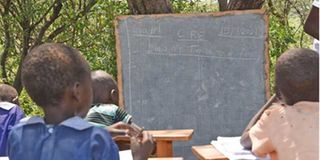Address these 3 concerns in new education reforms

Grade One pupils at Chepng’arwa Primary School in Tiaty, Baringo County learn under a tree as this is a routine, on September 15, 2021.
The Education Cabinet Secretary and senior staff and the TSC deserve accolades for unveiling the sessional paper on national education policy and 12 draft Bills on various aspects on education barely six months after the release of the final report of the Presidential Working Party on Education Reforms.
A perusal of these documents raises a number of salient issues that require to be ventilated upon.
First, the sessional paper has not come out clearly on a policy targeting preparation of the youth to acquire the requisite skills and competencies for export as migrant workers.
Way back in 1993, the Director General of Unesco set up an International Commission on Education for the Twenty First Century that was intended to seek an answer to the question “what kind of education is needed for the world of tomorrow?”
Contributing to this discourse, Daniel Blondel identified demography as one of the three main influencers of the development of the world economy and society. Thirty years later we have hardly taken advantage of this reality to educate Kenyan youth to exploit the employment opportunities that are arising from declining populations in the developed countries. Philippines, for example, gets over US$40 billion annually from migrant skilled labour; an amount equivalent to nine times Kenya’s current education budget.
An omission of a policy direction in the draft sessional paper on this subject can only mean that we will not address it for many years to come yet the President is lobbying for export of skilled labour.
Second, there are stakeholders who have been hoping that Grade Nine students will be relocated to Senior Schools to take advantage of teachers and facilities that are available at that level.
But what is the situation currently in public Junior Schools? Classrooms for Grade Nine, laboratories, workshops and music rooms are non-existent. The teachers are inadequate and the TSC does not seem to have decided whether to provide them according to the pupil-teacher ratio or the curriculum based establishment as has traditionally been the case.
The Ministry is reported to be underfunded by Sh20 billion. It behoves the parliamentary committees of education to recommend the adjustment of the budget upwards for JS in order to salvage them from the current situation or amend the Bill to provide for Grade Nine students to be domiciled in Senior Schools. This way their challenges will be ameliorated.
The third policy omission in the sessional paper is the plight of non-teaching staff in basic educational institutions who lack a uniform scheme of service and pension scheme. Every school has been left to deal with their workers in ways that they deem fit. This is complicated by the diverse financial situation in these schools and the lack of a recognition agreements between the boards of management and the trade unions. These staff have aspirations for themselves and their children similar to those of the children they serve yet they are not treated well by the schools. There is need to address these concerns.
- Mr Sogomo is an education expert and former TSC secretary; [email protected]. @Bsogomo





